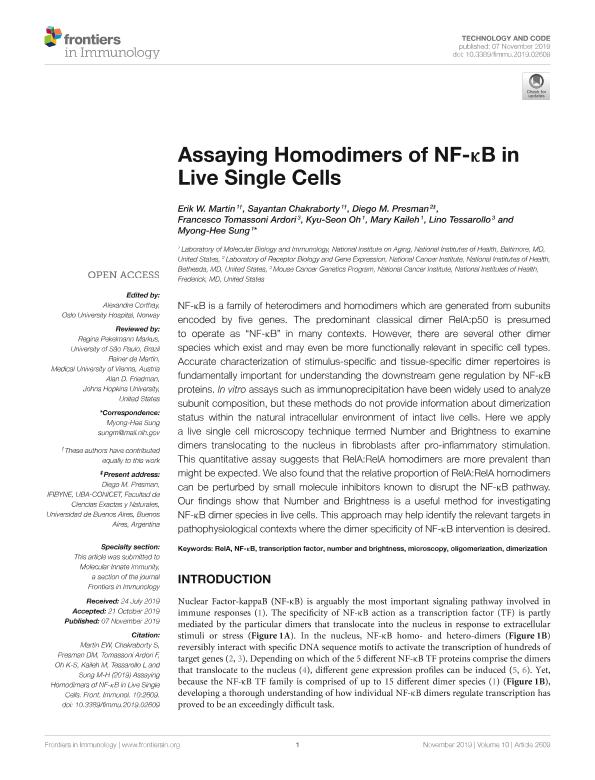Mostrar el registro sencillo del ítem
dc.contributor.author
Martin, Erik W.
dc.contributor.author
Chakraborty, Sayantan
dc.contributor.author
Presman, Diego Martin

dc.contributor.author
Tomassoni Ardori, Francesco
dc.contributor.author
Oh, Kyu Seon
dc.contributor.author
Kaileh, Mary
dc.contributor.author
Tessarollo, Lino
dc.contributor.author
Sung, Myong Hee
dc.date.available
2021-01-14T19:48:00Z
dc.date.issued
2019-11
dc.identifier.citation
Martin, Erik W.; Chakraborty, Sayantan; Presman, Diego Martin; Tomassoni Ardori, Francesco; Oh, Kyu Seon; et al.; Assaying Homodimers of NF-κB in Live Single Cells; Frontiers Research Foundation; Frontiers in Immunology; 10; 11-2019; 1-9; 2609
dc.identifier.uri
http://hdl.handle.net/11336/122771
dc.description.abstract
NF-κB is a family of heterodimers and homodimers which are generated from subunits encoded by five genes. The predominant classical dimer RelA:p50 is presumed to operate as “NF-κB” in many contexts. However, there are several other dimer species which exist and may even be more functionally relevant in specific cell types. Accurate characterization of stimulus-specific and tissue-specific dimer repertoires is fundamentally important for understanding the downstream gene regulation by NF-κB proteins. In vitro assays such as immunoprecipitation have been widely used to analyze subunit composition, but these methods do not provide information about dimerization status within the natural intracellular environment of intact live cells. Here we apply a live single cell microscopy technique termed Number and Brightness to examine dimers translocating to the nucleus in fibroblasts after pro-inflammatory stimulation. This quantitative assay suggests that RelA:RelA homodimers are more prevalent than might be expected. We also found that the relative proportion of RelA:RelA homodimers can be perturbed by small molecule inhibitors known to disrupt the NF-κB pathway. Our findings show that Number and Brightness is a useful method for investigating NF-κB dimer species in live cells. This approach may help identify the relevant targets in pathophysiological contexts where the dimer specificity of NF-κB intervention is desired.
dc.format
application/pdf
dc.language.iso
eng
dc.publisher
Frontiers Research Foundation

dc.rights
info:eu-repo/semantics/openAccess
dc.rights.uri
https://creativecommons.org/licenses/by/2.5/ar/
dc.subject
DIMERIZATION
dc.subject
MICROSCOPY
dc.subject
NF-ΚB
dc.subject
NUMBER AND BRIGHTNESS
dc.subject
OLIGOMERIZATION
dc.subject
RELA
dc.subject
TRANSCRIPTION FACTOR
dc.subject.classification
Bioquímica y Biología Molecular

dc.subject.classification
Ciencias Biológicas

dc.subject.classification
CIENCIAS NATURALES Y EXACTAS

dc.title
Assaying Homodimers of NF-κB in Live Single Cells
dc.type
info:eu-repo/semantics/article
dc.type
info:ar-repo/semantics/artículo
dc.type
info:eu-repo/semantics/publishedVersion
dc.date.updated
2020-11-13T20:43:58Z
dc.identifier.eissn
1664-3224
dc.journal.volume
10
dc.journal.pagination
1-9; 2609
dc.journal.pais
Suiza

dc.journal.ciudad
Lausana
dc.description.fil
Fil: Martin, Erik W.. National Institutes of Health; Estados Unidos
dc.description.fil
Fil: Chakraborty, Sayantan. National Institutes of Health; Estados Unidos
dc.description.fil
Fil: Presman, Diego Martin. Consejo Nacional de Investigaciones Científicas y Técnicas. Oficina de Coordinación Administrativa Ciudad Universitaria. Instituto de Fisiología, Biología Molecular y Neurociencias. Universidad de Buenos Aires. Facultad de Ciencias Exactas y Naturales. Instituto de Fisiología, Biología Molecular y Neurociencias; Argentina
dc.description.fil
Fil: Tomassoni Ardori, Francesco. National Institutes of Health; Estados Unidos
dc.description.fil
Fil: Oh, Kyu Seon. National Institutes of Health; Estados Unidos
dc.description.fil
Fil: Kaileh, Mary. National Institutes of Health; Estados Unidos
dc.description.fil
Fil: Tessarollo, Lino. National Institutes of Health; Estados Unidos
dc.description.fil
Fil: Sung, Myong Hee. National Institutes of Health; Estados Unidos
dc.journal.title
Frontiers in Immunology
dc.relation.alternativeid
info:eu-repo/semantics/altIdentifier/doi/http://dx.doi.org/10.3389/fimmu.2019.02609
dc.relation.alternativeid
info:eu-repo/semantics/altIdentifier/url/https://www.frontiersin.org/articles/10.3389/fimmu.2019.02609/full
Archivos asociados
